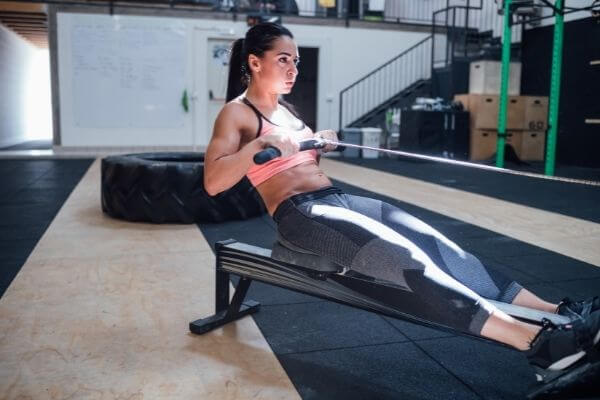When it comes to working out, there are many different options to choose from. If you’re looking for a cardio workout that is low-impact and gentle on the joints, rowing is a great choice. But how long should you row for? And how hard should you work? In this guide, we will answer all your questions about rowing and help you create the perfect workout routine!
Disclaimer: There is no single, definitive answer to how long you should row for.
One approach is to break up your rowing session into different time intervals, such as 1 minute, 5 minutes, 15 minutes, or 30 minutes. Some people may find that rowing for short bursts of time is better for their exercise routine, while others may prefer to row for longer stretches.
Ultimately, the most important thing is to listen to your body and pay attention to how you’re feeling during each session.
Remember: If you start to feel sluggish or drained, it might be a sign that you need to take a break or switch up your routine somehow.
Whether you decide to row for 2 minutes or 20 minutes, make sure that you’re always doing whatever is right for your body to maximize the benefits of this incredibly effective form of exercise!
Table of Contents
What Are Your Rowing Goals?

Your goals are a crucial factor when setting your workout’s duration. Are you rowing to improve your cardiovascular health? Are you hoping to build muscle and tone your body? Are you trying to lose weight? Depending on your specific goals, you will need to row for different lengths of time.
Related: 5 Rowing Machine Benefits And 4 Crucial DRAWBACKS To Consider
Let’s break these down below:
Rowing for Cardio Endurance
When it comes to working out, there’s a lot of debate about the best way to increase cardio endurance. Some people swear by running, while others prefer swimming or cycling. But rowing is the perfect solution for those who want to get a great workout without putting a lot of stress on their joints.
So how long should you row to see the most significant benefit?
According to fitness experts, 20-30 minutes is all you need. That’s because rowing is an excellent way to get your heart rate up without putting too much strain on your body. In fact, studies have shown that rowing can be just as effective as running when it comes to increasing cardio endurance.
Pro tip: If you’re looking to improve anaerobic conditioning, 5-15 minutes of HIIT rowing will do the trick.
Rowing to Lose Weight
There is no one-size-fits-all answer to this question, as the amount of time you need to spend rowing will depend on several factors, including your weight, fitness level, and calorie goals.
However, a good rule of thumb is to aim for 30 minutes of rowing per day.
This amount of time will provide a solid workout without overstressing your body. Besides burning hundreds of calories within a short half an hour, rowing also improves muscle mass and cardiovascular health, accelerating your metabolism.
As such, you can lose more weight even when you’re not exercising.
Related: Rowing for Weight Loss: The Complete Guide
Rowing to Build Muscle
Rowing is a great way to build muscle. But how long should you row to see results?
Rowing for 50 minutes at a moderate intensity will likely lead to different results than rowing for 20 minutes at a high intensity. So, the best way to figure out how long you should row for is to experiment and find what works best for you.
But in general, longer rows are better for building muscle:
- If you’re looking to bulk up, aim for 45 minutes and add some weight training to your routine.
- 20-30 minutes will do the trick if you only want to tone your muscles.
How Often Should You Row?

There is no single universal answer regarding how often you should row.
The frequency of rowing will depend on many different factors, including your individual training goals and the intensity of your workouts. Some rowers may choose to practice daily, while others might prefer to take several days off after a particularly grueling workout.
Ultimately, the best strategy is to listen to your body; pay attention to how you feel each day and adjust your rowing schedule accordingly. By ensuring that you are adequately rested and hydrated before beginning each workout, you can increase your odds of having a successful and productive row.
Pro tip: Allow your muscles at least a rest day in-between challenging rows, especially if you’re feeling very sore.
How Long Should You Row on a Rowing Machine?
Here’s a rundown of a few rowing machine training periods and the goals you may accomplish during them.
10 Minutes a Day Rowing Results
Ten minutes a day of rowing can produce a calorie deficit of 100-200 calories.
If you’re not used to workouts, just ten minutes will dramatically change your flexibility, endurance, and tone.
But on a psychological level, regular rowing has been shown to reduce stress levels and improve mood. At the end of the day, spending just ten minutes a day exercising can positively impact every aspect of your life.
20 Minutes a Day Rowing Results

If you row for 20 minutes a day, you can expect to see an even greater calorie deficit: up to 400 calories if you’re exercising hard.
However, maintaining a maximum capacity for 20 whole minutes is difficult. So, perhaps 250 calories are a likelier result. As a bonus, you will see faster lean muscle building and more endurance.
30 Minutes a Day Rowing Results
Thirty minutes a day of rowing can produce a calorie deficit of 300-400 calories a day. However, if you’re challenging yourself adequately, you’ll notice sore muscles the next day.
That means you’ll need a rest day instead of another tough workout.
That said, regular 30-minutes/day rowing can help to strengthen your muscles, improve your cardiovascular health, and boost your overall endurance. Additionally, you’ll see more muscle building and fat burn.
45 Minutes to One Hour a Day Rowing
Forty-five minutes to one hour a day of rowing can produce a calorie deficit of 400-600 calories a day. This is the ideal range for serious rowers looking to make significant changes to their physique.
At this point, you’re probably rowing at a moderate to high intensity and reaping all the benefits that come with it.
1 Month Rowing Machine Results

After one month of using an indoor rowing machine, most people will notice increased cardio endurance. Those who work out for more extended periods may also see an increase in strength and stamina.
By mixing up the length and intensity of workouts, rowers can achieve tangible before and after results within a short period.
Here’s what you can expect:
- 10 minutes per day: One pound weight loss; better sleep; more endurance; reductions in levels of stress and fatigue; more mental clarity
- 20 minutes per day: Two-pound weight loss; toned muscles; increased stamina
- 30-minutes per day, 3-4 times/week: Three-pound weight loss; increased muscle mass; more cardiovascular resistance
- 45-minutes per day, 3-4 times per week: Four-five pounds weight loss; higher muscle-to-fat ratio; aerobic and anaerobic conditioning
Perhaps most importantly, those who stick with their daily rowing routine will likely develop healthier eating habits and find that weight loss becomes easier over time. So if you’re looking for a way to kick-start your fitness journey or get back on track after some setbacks, look no further than an indoor rowing machine.
It will get you where you want to go!
- 7 Exercises for Pregnant Women in the First Trimester: Safe and Effective - January 30, 2025
- Our equipment recommendations - October 30, 2024
- Here’s What Doing Cardio Every Day Does To Your Body - August 21, 2024

